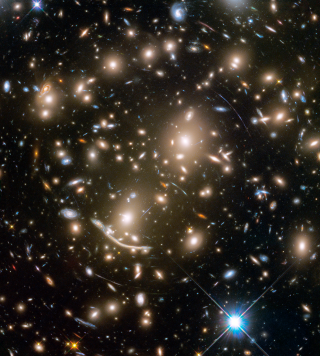Bibcode
Pérez, I.; Aguerri, J. A. L.; Méndez-Abreu, J.
Bibliographical reference
Astronomy and Astrophysics, Volume 540, id.A103
Advertised on:
4
2012
Journal
Citations
39
Refereed citations
35
Description
Context. The tumbling pattern of a bar is the main parameter
characterising its dynamics. From numerical simulations, its evolution
since bar formation is tightly linked to the dark halo in which the bar
is formed through dynamical friction and angular momentum exchange.
Observational measurements of the bar pattern speed with redshift can
restrict models of galaxy formation and bar evolution. Aims: We
aim to determine for the first time the bar pattern speed evolution with
redshift based on morphological measurements. Methods: We have
selected a sample of 44 low-inclination ringed galaxies from the SDSS
and COSMOS surveys covering the redshift range 0 < z < 0.8 to
investigate the evolution of the bar pattern speed. We derived
morphological ratios between the deprojected outer ring radius
(Rring) and the bar size (Rbar). This quantity is
related to the parameter ℛ = RCR/Rbar used
for classifiying bars in slow and fast rotators, and allows us to
investigate possible differences with redshift. Results: We
obtain a similar distribution of R at all redshifts. We do not find any
systematic effect that could be forcing this result. Conclusions:
The results obtained here are compatible with the main bulk of the bar
population (~70%) being fast-rotators and with no evolution of the
pattern speed with redshift. We argue that if bars are long-lasting
structures, the results presented here imply that there has not been a
substantial angular momentum exchange between the bar and halo, as
predicted by numerical simulations. In consequence, this might imply
that the discs of these high surface-brightness galaxies are maximal.
The appendix is available in electronic form at http://www.aanda.orgBased on
observations made with the NASA/ESA Hubble Space Telescope, obtained
from the data archive at the Space Telescope Science Institute. STScI is
operated by the Association of Universities for Research in Astronomy,
Inc. under NASA contract NAS 5-26555.
Related projects

Starbursts in Galaxies GEFE
Starsbursts play a key role in the cosmic evolution of galaxies, and thus in the star formation (SF) history of the universe, the production of metals, and the feedback coupling galaxies with the cosmic web. Extreme SF conditions prevail early on during the formation of the first stars and galaxies, therefore, the starburst phenomenon constitutes a
Casiana
Muñoz Tuñón

Galaxy Evolution in Clusters of Galaxies
Galaxies in the universe can be located in different environments, some of them are isolated or in low density regions and they are usually called field galaxies. The others can be located in galaxy associations, going from loose groups to clusters or even superclusters of galaxies. One of the foremost challenges of the modern Astrophysics is to
Jairo
Méndez Abreu